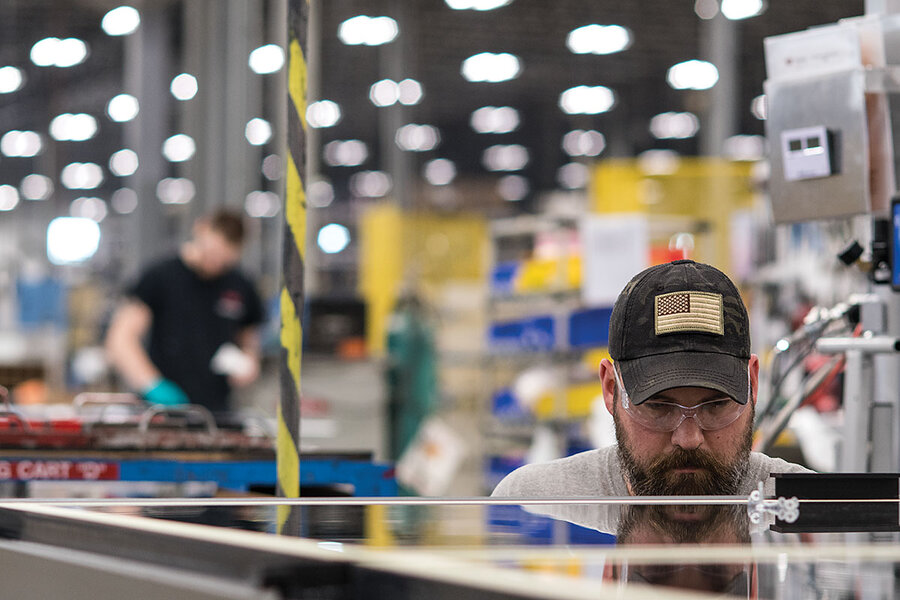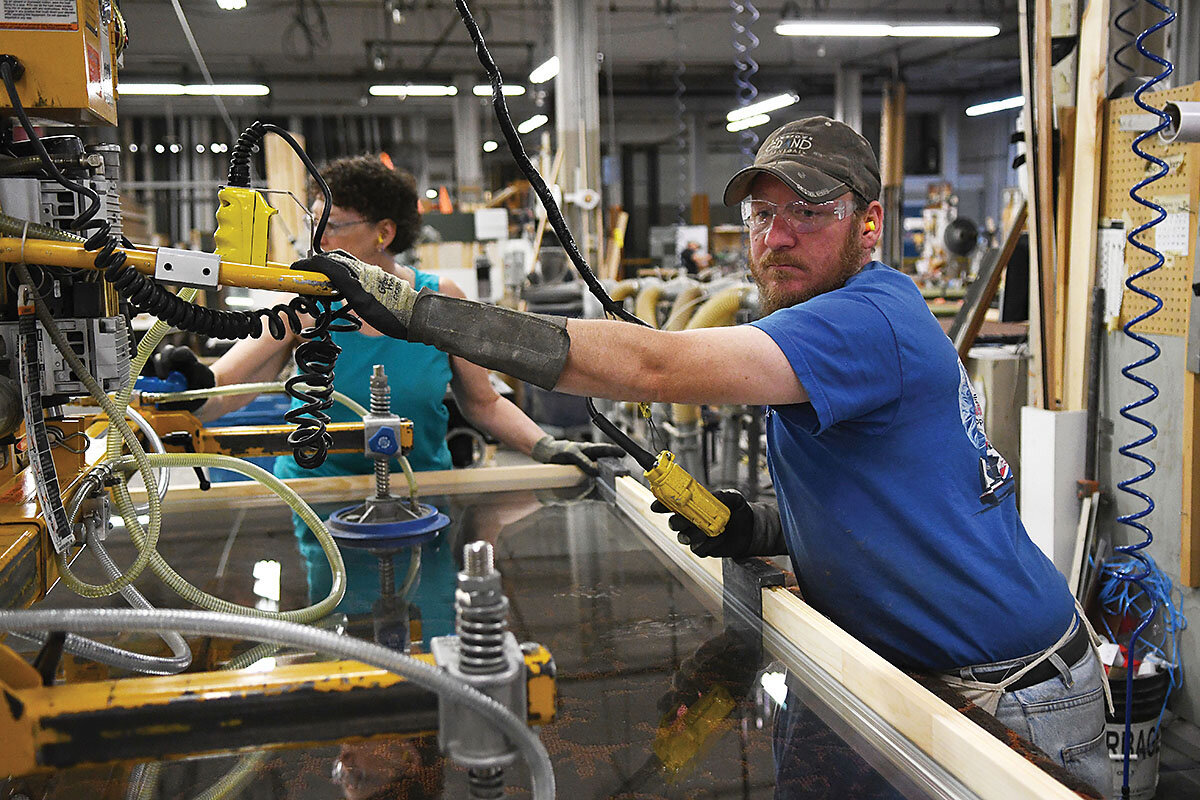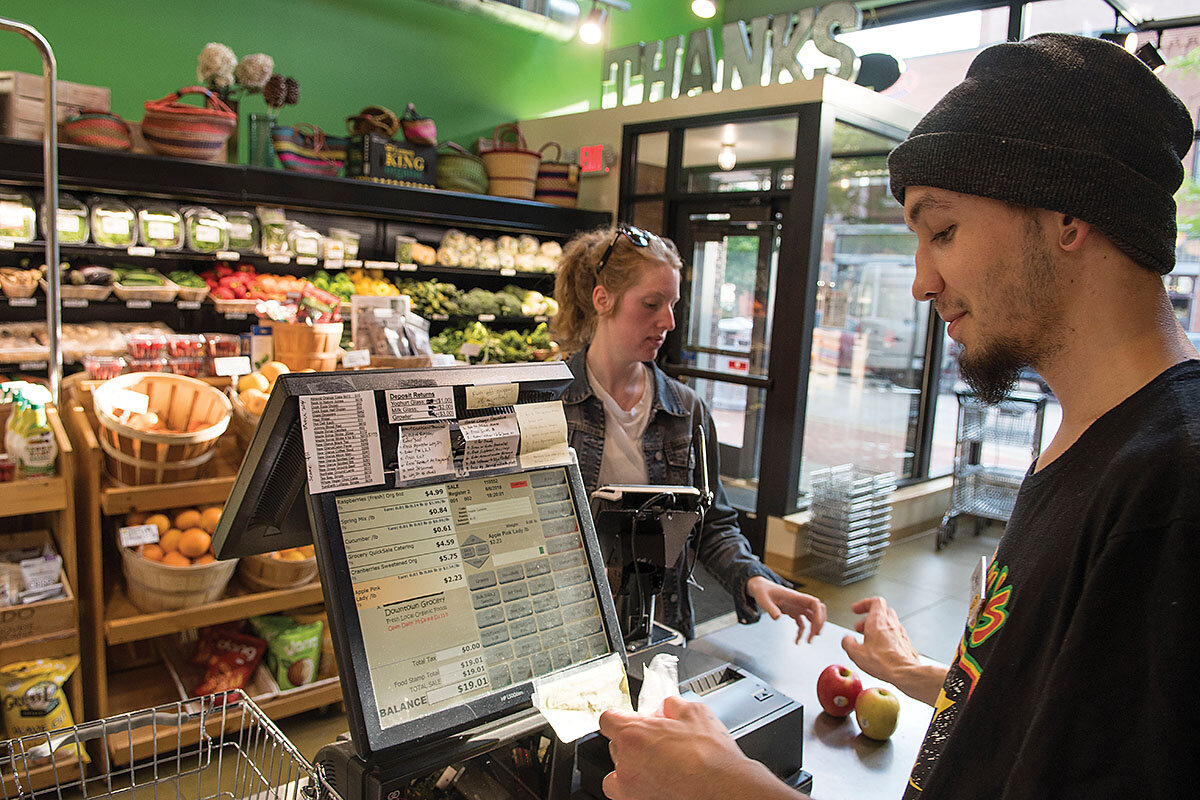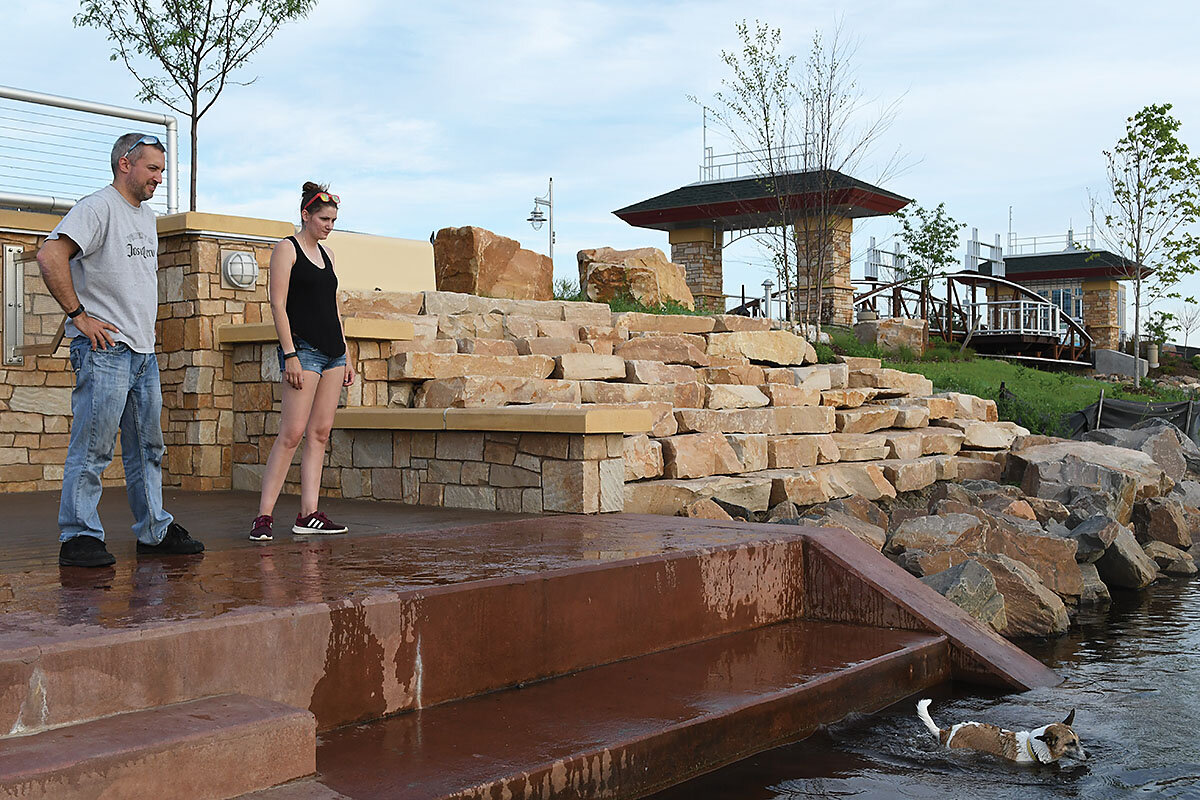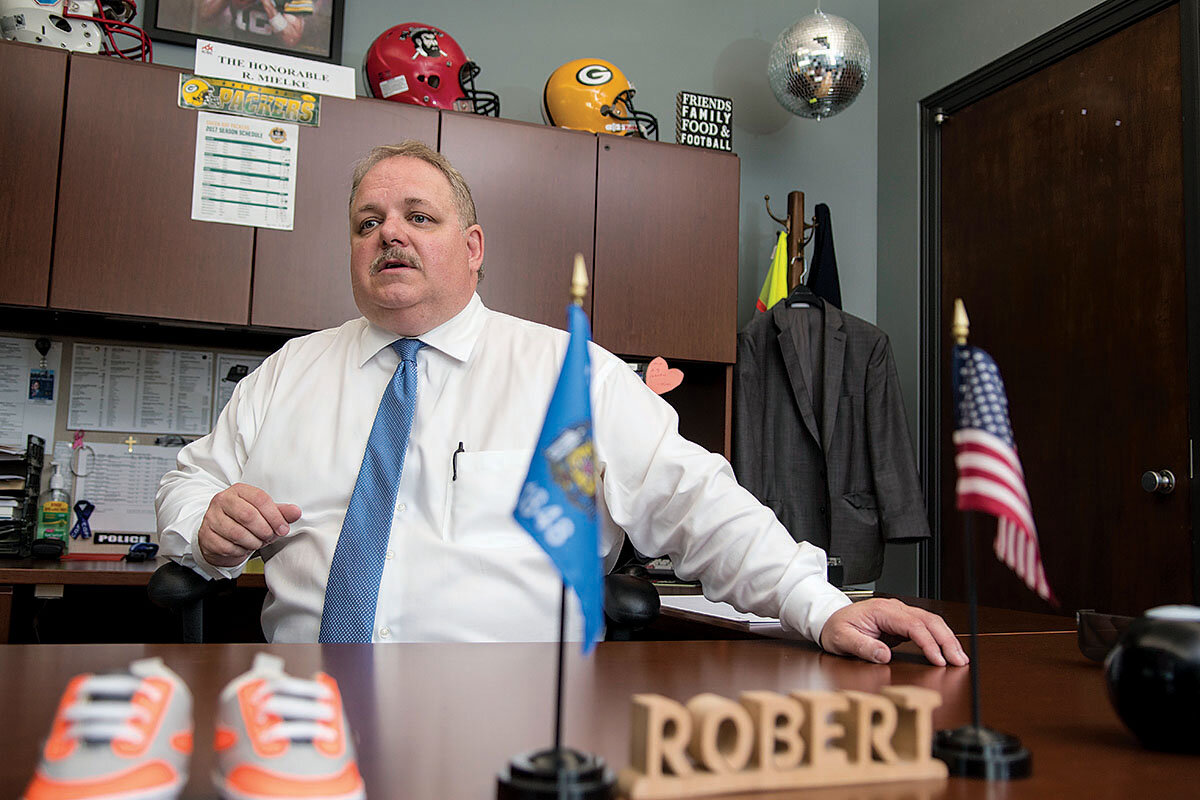Help wanted now! What full employment looks like in one Wisconsin city
Loading...
| Wausau, Wis.
On a Thursday evening in late May, the crew cleaned up the Wendy’s restaurant one last time and then defiantly walked out.
They left this hand-lettered sign in the window:
“Due to this corporation’s refusal to pay a living wage and deal with problems before it’s too late, the employees you would have dealt with today have all walked off the job. We wish you all the best.”
Why We Wrote This
For the first time since the Bureau of Labor Statistics began tracking job openings 18 years ago, there are more positions available than workers to fill them. Wausau, Wis., offers a glimpse into what that may mean for both workers and companies across the US.
The move would have rattled management anywhere, but here in a suburb of Wausau, Wis., it was especially troubling. In a city with an unemployment rate below 3 percent and companies struggling to find someone – almost anyone – to keep their operations going, any threat of similar actions would reverberate ominously through executive suites. Would other workers lay down their restaurant spatulas and factory tools to protest long hours and low pay?
Not exactly. The assistant manager who led the revolt soon found another job – at Arby’s, per her Facebook page. (She declined to be interviewed for this story.) The restaurant owner, a Florida-based company that owns 180 Wendy’s in nine states, scrambled to open the restaurant the next day, apparently with employees pulled from other cities. Within six days, it was training a crew and operating close to normal hours. Instead of resorting to confrontation, Wausau is so far forging a more cooperative path as the worker shortage tips the balance of power away from management and toward labor. As expected, companies are quietly raising wages and improving benefits. But they’re also hiring and training people they wouldn’t have considered before: ex-convicts, homeless people, former drug users. The shift toward greater inclusion is occurring in the middle of another momentous change: the retirement of baby boomers and the rise of Millennials, who by 2020 will make up half of the US workforce. These forces are combining to force employers to rethink how they hire and retain workers, who now have a bevy of choices.
In a year or two, the rest of the United States could find itself in the same position if the nation continues to add new jobs at its current rapid pace. Earlier this year, the Bureau of Labor Statistics reported that for the first time since it began tracking job openings 18 years ago, there were more positions available than there were workers to fill them. In that way, Wausau offers a glimpse into what cities and towns across the country may be facing in the future.
***
Wausau itself seems a throwback to an older, small-town America. Steeples are prominent. Locally owned shops are active with virtually no vacancies. Some streets remain brick instead of asphalt.
There’s a friendliness here more famously connected with Minnesota than northern Wisconsin. Perhaps it’s Wausau’s relative isolation. With 39,000 people, it’s the biggest city in nearly 100 miles in any direction. A postman stops to talk with a neighbor; a construction worker waves to a stranger.
Though not as racially diverse as many American cities and more dependent on manufacturing, Wausau is in many ways a microcosm of the US economy. It combines small and midsize manufacturing plants with a broad mix of service firms, including insurance companies and banks, a mail-order athletic gear business, and a growing health-care provider. It has the usual big-box stores and small retail outlets. In 2016, researchers at Pew named Wausau the most egalitarian city in the US, with a bigger share of its population in the middle class than anywhere in the country.
What almost all businesses here share in common, whether in the Old Economy or New, is one simple problem: a shortage of workers. Walk into practically any business in this tidy city in north-central Wisconsin, in fact, and the refrain is the same: “Probably right about now I could use 40 to 45 [new workers],” says Keith Koenig, vice president of manufacturing at Kolbe & Kolbe, a large manufacturer of windows and doors.
“If you are unemployed you can pretty much pick the business you want,” says Miranda Lezcano, district director at the state unemployment office, which these days is quieter than a library. In front of her, a “hot jobs” bulletin board is plastered with some two-dozen offerings from school bus drivers to restaurant workers. “If you want to work a factory job, they are fighting for good people,” she adds.
Wausau Coated, which makes labels for olive oil, wines, and squeezable mayonnaise bottles, hasn’t been fully staffed for three years. Owner Ben Reif raised the starting wage to $15 an hour 18 months ago, reduced the time it takes to earn paid vacation, and boosted the company’s match in the 401(k) retirement program. And he’s still 18 to 25 people short out of a workforce of 300.
It’s not that no one’s applying for work. But “the people who are walking in the door to work for us, they have got” – Mr. Reif pauses to find the right word – “issues. They don’t show up for work. They have had trouble with the law.”
Even after the best of the candidates have been trained, 10 to 15 percent don’t work out or move on to another job. Despite these setbacks, Reif doesn’t have much choice but to keep recruiting. He recalls one young hire who had problems with alcohol. He missed work for a number of days. “We had to let him go,” he says.
When the company learned the man had dealt with his problems, Reif, although apprehensive, rehired him. “Seven years ago, I don’t know I would have done that,” he says. But “we took a chance on this guy, and two years later he’s a line operator and he’s one of our best employees.”
Last summer, Jacob Abendroth was living in a tent on an island in the Wisconsin River that is connected to Wausau by a little footbridge. “I went through a bad divorce and alienated myself from my children,” he recalls. He had started drinking heavily, lost his construction job, sobered up and got it back again, only to return eventually to bad habits and get fired. He lost his apartment and camped on the island for 60 days.
“I think it rained 55 of those days,” he says, which dampened his enthusiasm for his chosen lifestyle. “I know I’m better than this,” he remembers thinking. “I’ll pack up in the morning and get out of here.” It helped that the local police had told him that evening he had to vacate the park.
He checked into a homeless shelter and saw a notice about the Joseph Project, a program started in Milwaukee that connects people in need of stability with employers in need of workers. Mr. Abendroth went through three days of job-training boot camp and then visited Kolbe & Kolbe. As a construction worker, he had plenty of experience hanging aluminum windows and doors. Now, he might make them.
“I saw his application and background and said, ‘You are very qualified,’ ” says Ann Micholic, Kolbe’s vice president of human resources. “He began to tell me his story. From a community standpoint, there was no question that we would be pleased to have him join our team.”
In August, Abendroth will celebrate a year with the company. He’s a glazier working on the company’s curved windows, the most complicated in which to install glass. “I absolutely love what I do,” he says. “A lot of it is pretty cerebral.”
Kolbe continues to hire people through the Joseph Project, even though half don’t last. “The vast majority of them have been troubled by drugs and alcohol,” says Ms. Micholic. “Many people think these are violent criminals. They’re not! They are people seeking safety.”
***
Wausau’s economy hasn’t always been so vibrant. It has been subject to the vicissitudes of national and international business cycles as much as anyplace else.
Eight years ago, for example, the Great Recession had closed mills and factories that had been here for decades. With a fifth of its workforce in manufacturing, the city’s unemployment rate shot up to 14.6 percent. The following year, in a single week, a window-and-door manufacturer and a paper mill in the county announced plant closings that would throw 1,000 people out of work.
“That was awful,” recalls Robin Hegg, who at the time worked in human relations with a large local manufacturer that laid off 10 percent of its workers, many of them friends and neighbors. “We did whatever we could to help them with the transition.”
Then something dramatic happened. While the nation recovered slowly, Wausau’s economy gathered steam and now enjoys an unemployment rate of 2.7 percent – more than a percentage point below the national average. Only four other US cities with a population of at least 25,000 have moved so quickly from greater than 14 percent unemployment in 2010 to below 3 percent today. Santa Cruz and Seaside are coastal California cities where a local university and tourism play a big role. The turnaround of the recreational vehicle industry has fueled the recovery in Elkhart and Goshen, Ind.
Wausau’s rebound is more broad-based. The nearby Granite Peak ski resort brings in tens of thousands of tourists each winter. Adding to the strong turnaround of its traditional industries – including manufacturing, insurance, and mail-order sports gear – is the rapid expansion of a nonprofit health-care provider, Aspirus, which is now the largest employer in the county.
The revival has happened fast enough that employers are still scrambling to adjust from a period of surplus labor to worker shortage. And that shortage, coupled with the transition of replacing retiring boomers with rising Millennials, is pushing Wausau into a new era. Unemployment is lower than it has ever been, according to federal statistics going back to 1990. State jobless numbers, dating to 1974, have never been lower, either.
The change is most visible at Northcentral Technical College, a two-year school that graduates about 1,670 students a year. In the past two years, the average age of students has dropped from 33 to 23, as the last of the older workers, who had enrolled to upgrade their skills, found new jobs and more Millennials registered to further their education. NTC boasts a new basketball court and other sports facilities, a restaurant, and a break room designed by the students, who asked for on-campus places to hang out with their friends.
Employers, too, are trying to create spaces and new cultures that cater to Millennials.
“There was no ‘aha’ moment,” says Mark Mudler, co-owner of Integra Tool & Manufacturing, who recalls his own apprenticeship in a tool-and-die shop where he was constantly in fear of losing his job. “They’re softer.... You have to be kinder and gentler.”
Mr. Mudler’s new approach seems to be working. “I’m pretty happy with this place here,” says Dan Polak, a young press operator making $15.50 an hour and the newest employee in the nine-person shop.
Part of what employers are doing to appeal to a new generation of workers is to emphasize the uniqueness of their businesses. Down the street from the Back When Cafe and next to a candy store, the Downtown Grocery looks a little out of place. Its shelves of organic broccoli and locally grown greens, gluten-free baked goods, and exotic products from around the world might seem better suited for a bigger city with a university, like Green Bay, 100 miles to the east, or better yet, Madison. But here in blue-collar Wausau, where there’s no four-year college population, how does a high-end organic boutique survive?
“We don’t use words like that,” says co-owner Kevin Korpela. “We’re an old-fashioned grocery.... If you look at what our grandfathers and grandmoms did, they were doing the same thing. They just didn’t call it grass-fed or organic.” A little child on a tree swing is the company logo.
The branding seems to work for Jake Benson, one of the grocery’s newest employees, who changed jobs to work here in part because it’s closer to home and he can bike to the store. “I love all the people I’m working with,” he says. Although he makes only $9 an hour, he also gets a free lunch. “I am a vegan so I really appreciate all the food options that are here.”
Many local employers are refashioning their image with Millennial workers in mind. “When they think of River Valley Bank, we want them to think of banking with a purpose,” says Ms. Hegg, who is now chief human resources officer with the local bank.
Even the local police are adopting a different approach. “This generation is looking for a cause. They want to be part of something that’s bigger than themselves,” says Todd Baeten, a patrol captain. “It definitely works in our favor when we talk about principle-based policing.”
The department is trying to fill three positions and anticipates two more openings when officers retire at the end of the year. (Crime has not gone down, he says, even though more people are working.)
***
For all of Wausau’s successes, uncertainties still hang over the city. One question is whether the economy is making it too easy for Millennials to skip from job to job before they build the skills to move up.
On a Wednesday evening at a packed Texas Roadhouse just out of town, Frank, a waiter and high school graduate with a ready smile, drops off the check. “Thanks for being a great table,” he says. Frank, who doesn’t want his real name used, says the restaurant is constantly hiring new people because workers don’t stick around. After two months on the job, he is cutting back his own hours so he can work as a lifeguard.
Earlier that day at 400 Block, a green space that’s become the heart of downtown, volunteers are hosting the annual Law Enforcement Torch Run for Special Olympics Wisconsin. Five police cars, with lights flashing and sirens going, glide past Erbert & Gerbert’s Sandwich Stop to lead a parade for a few blocks, and then about 60 racers, some on foot, others in wheelchairs, take off for a 5K run. Through it all, a half-dozen young men on bicycles, sporting police radios and T-shirts with CSO (Community Services Officer) in big letters, manage the traffic so everything starts on time.
By giving young people a taste of what policing is like, the department hopes to entice more recruits. The pitch is working for Dave Juzwiak, a student in law enforcement at NTC. “I will be graduating this December, and I am optimistic I can go where I want,” he says.
But it’s not working for Ryan Lynch, who is switching to fire and ambulance work. “It’s probably a little bit easier [than police work],” he says. “You don’t have to have a two-year degree.”
Another troubling question: Why hasn’t the economic boom slashed the poverty rate? The local United Way, which tracks the working poor through its own measure called Asset Limited, Income Constrained, Employed (ALICE), finds that just over half the county’s poor are in the labor force. In other words, many are working but not making a living wage.
“You’d think the ALICE population would narrow until it disappears,” says Jim Waldron, a board member of the local United Way and president of Wausau Window and Wall Systems, which has 30 to 50 open positions starting at $15 an hour. But “the ALICE population is not shrinking. I have no good answers for that.”
The other big question is what will happen when the boom ends. Typically in a recession the last hired are the first fired and the gains that the least qualified workers make during the good times are quickly erased. But the city is projecting that its worker shortage will last through at least 2028, because of impending boomer retirements and predicted job needs.
***
Wausau has a long history of business leadership, dating back to the late 19th century, when lumber barons diversified into papermaking and door-and-window manufacturing. The city became an insurance hub, too. Local industries reinvented themselves then, and now the business community is being forced to innovate again – this time in finding new ways to recruit workers.
In part, that means persuading current residents to stay. Concerned about the lack of welders and machinists, a group of local manufacturers sponsors a high school welding competition and worked to expand NTC’s welding program. The group also hosts the Heavy Metal Tour, in which every eighth-grader in Wausau and surrounding school districts sees firsthand what modern factories look like.
The students aren’t that impressed, but the teachers are fired up, says Mr. Waldron, whose Wausau Window is one of the sponsors. “They go back to the classroom and tell the students: ‘You can get $16 an hour!’ ”
The city is also trying to appeal to outsiders – not always easy for a place where the winters are cold and long. It’s transforming its riverfront with bike paths and new housing. It has helped a developer create the city’s first town houses, which are aimed at both Millennials and empty nesters.
“We would be pretty happy if we had 50 percent sold by Christmas,” says Phil Larkin, the project’s salesman, showing off a freshly painted three-bedroom unit at one end of the development while a piece of Tyvek flutters from an unfinished wood frame at the other end.
The city’s Live It Up program, now in its third year, has given out $467,000 to help 33 people from outside Wausau put a down payment on a home. All these programs have caused the city to spend heavily.
“I used to be on the city council and asked: ‘Why are we spending money on these businesses?’ ” says Mayor Robert Mielke. “I don’t believe that anymore.... If we don’t do that stuff, we will get left behind.”
Historically, not all of Wausau’s initiatives have worked. The downtown enclosed mall, so innovative when it opened in 1983, is struggling, like many malls in America. Local control of corporations, which strengthened the civic bond between company owners and workers and helped fund local arts and culture, is slipping away. Liberty Mutual Group in Boston took over Wausau Insurance in 1998. Wausau Window and Wall Systems and Linetec, two big manufacturers in town, are run by Apogee Enterprises in Minneapolis. Will Wausau-based firms, such as health-care provider Aspirus, offer similar leadership going forward?
With $10,000 from the Live It Up program for their down payment, Andrew Wieland and his girlfriend, Melissa Barak, were able to buy a 1970s-era split-level home in town. That gave them extra money to replace some of the original blue carpeting with hardwood flooring and remove old wallpaper so they could paint several rooms. They kept the once-chic gold vein mirror tiles on the living room wall. “We thought it looked neat,” Mr. Wieland says.
“I love my job,” adds Wieland, a personal banker at River Valley Bank. “I will get offers on LinkedIn every once in a while, but nothing that I even entertain. It’s hard to imagine myself leaving those people [at work]. There’s a lot of interconnection between the communities.”
“Community-driven is a big deal,” Ms. Barak says, holding their daughter. “That’s what she is going to grow up with.”




